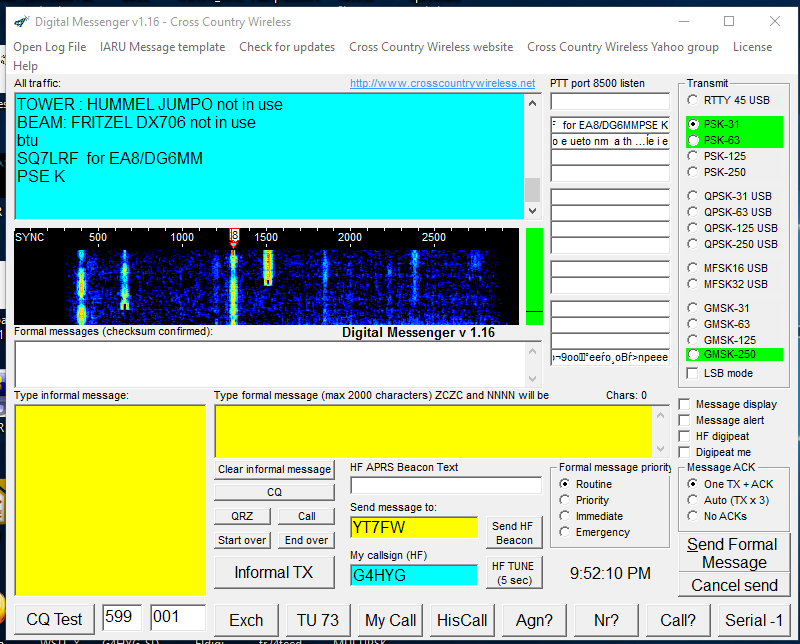
Cross Country Wireless Digital Messenger program

Cross Country Wireless Digital Messenger program

This is a datamodes program designed for informal and contest amateur radio use and formal emergency communications use where a text message up to 2000 characters long can be sent as a formal IARU formatted message.
As the program is based on the source code of APRS Messenger all formal messages are confirmed with a checksum. Formal messages can also be digipeated by another station running Digital Messenger if the checksum is confirmed by the digipeating station.
The program has 18 software receivers running simultaneously so that formal messages can be recieved in any of the modes used by the program. This also allows cross mode formal messaging if required.
The program can also be used to quickly identify the mode of an incoming transmission as short received text samples are displayed next to the transmit mode buttons.
The GMSK modes are useful as they can be run at full power through a SSB transceiver or Class C amplifier and have been proved to be very effective when received through noise and interference.
The latest version 1.17 has a bug fix to the port 8500 PTT output and a new UTC clock in the program frame.
Version v1.16 now has button and function key operated macros for fast contest operating. The function keys follow a similar layout to the N1MM+ Contest Logger. They are as follows:
F1 CQ call
F2 Contest exchange
F3 TU 73
F4 My call, my call
F5 His/her call
F6 Repeat exhange
F7 Not used
F8 Again? Again?
F9 Number?Number?
F10 Call?
Digital Messenger version 1.17 can be downloaded as a freeware 1.3 MB zip file here .
Video on Raynet Messenger operation by Jack McEwan, G8HIK. RAYNET Messenger was the original version of Digital Messenger
Version 1.16 is renamed Digital Messenger. It has new contest button and function key macros. It has a revised TCP/IP PTT output on port 8500 to send PTT requests to other programs including SDR transceivers. The other station's callsign can now be copied off te screen vy clicking and dragging on the callsign. Other minor bug fixes included.
Version 1.15 has a bug fix that now allows messages to be "cut and paste" from the "All traffic:" box without error and improvements to the short macro messages.
Version 1.14 has a bug fix in the transmitted messages logging, a simplified sound card selector and a new option to send one transmission with a request for an ACK.
Version 1.13 has bug fixes suggested by Marc, F6EMT. Thanks, Marc for the feedback.
Version 1.12 has a two new modes MFSK16 and MFSK32 added, revised layout with a LSB mode selector, IARU Message template button to open a message template in Notepad so that it can be "cut and pasted" into the Formal message box (thanks Jack, G8HIK) and a "self-training" feature where messages sent to the senders callsign can be received and acknowledged on the PC without a radio transceiver connected.
Version 1.11 has revised bandpass filters and AFC routines to improve reception of weak or fading signals.
Version 1.10 has a revised receiver routine for improved reception. The informal message function has been modified to allow typing a message before sending and typing or editing during transmit.
Version 1.8 has an output on TCP/IP port 8062 to connect the PTT line to other programs without a hardware connection.
Version 1.7 has a revised informal message code and additional macros for simple contest work.
Version 1.6 has the latest MMVARI soundcard engine, separate transmit and receive sound card selectors, sound card channel selector and a revised receiver routine to reduce the CPU load.
Version 1.5 has 18 simultaneous receivers decoding different mode and speed variations. It also has a CPU speed selector so that it can still run on slow PC's using PSK and GMSK modes.
Version 1.4 has corrected repeat message timing, a maximum formal message length of 2000 characters, a label showing formal character length, a clock display and minor bug fixes.
Version 1.3 has revisions to enable Acks and digipeating to work with longer formal messages.
Version 1.2 has a revised checksum routine. Only formal messages that are confirmed by checksum are displayed in the message boxes. The PTT routine has also been modified.
Version 1.1 has a revised layout to fit on the 800 x 600 pixel display of an old laptop or a 600 pixel high display on a modern notebook.
Contact Chris Moulding, G4HYG via info@crosscountrywireless.net